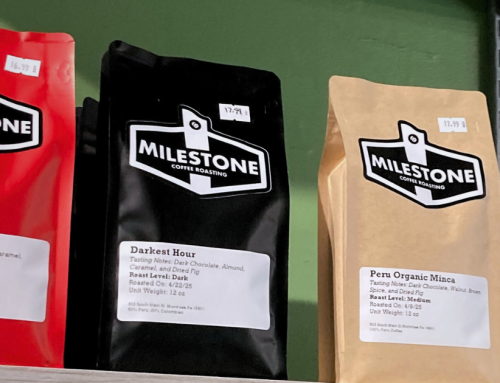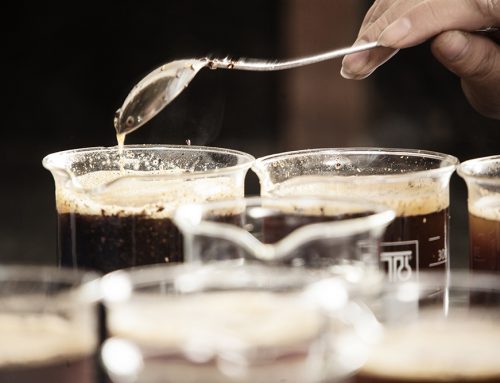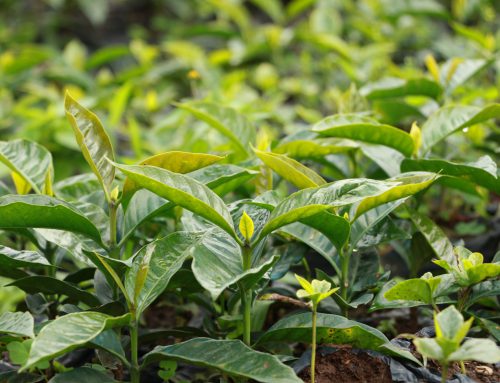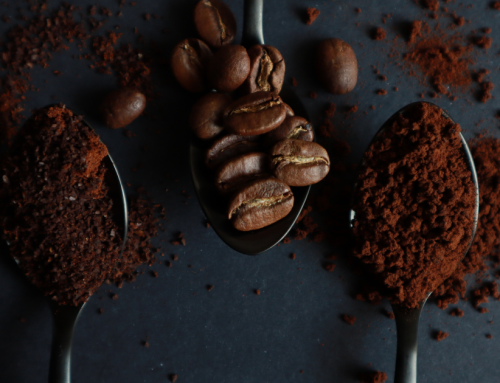Coffee filters come in many shapes, sizes, and materials. There are nearly as many types of coffee filters as there are coffee brewing devices. So many, in fact, it can be overwhelming to filter through all the options.
We’ve compiled this handy guide to determine what type of coffee filter is the best for your brewing method. That way, you can optimize every extraction for the best flavor profile as intended by the coffee farmer and coffee roaster that produced the specialty coffee beans going into your cup.
Types of Coffee Filter Shapes and Sizes
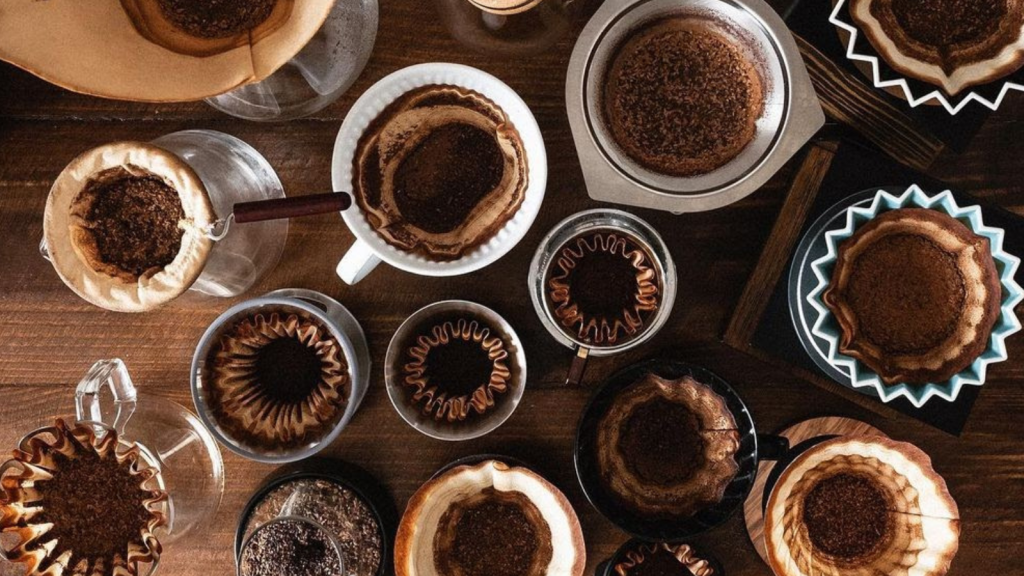
Assorted Coffee Brewers and Filters – Laude Creator – LD Photographer
Coffee filters vary in shape and size to fit different coffee makers. The best type of coffee filter will depend on your brewing device. The most common ones are:
Conical Filters – Cone-shaped coffee filters have a wide opening at the top and a pointed end at the bottom. They are designed to fit in cone-shaped coffee makers, whether they’re drip machines or pour over brewers, and come in different sizes to accommodate different coffee volumes.
Conical coffee filters come in four standard sizes:
- #1 for single-cup coffeemakers or pour over brewers
- #2 for 2-6 cup coffeemakers or 1-2 cup pour over brewers
- #4 for 8-10 cup coffeemakers or pour over brewers
- #6 for 10+ cup coffeemakers
Bucket, Basket, or Flat-Bottom Filters
These filters are often shaped like cupcake liners and either have folds around the sides or smooth edges. What they have in common is their flat bottoms instead of the pointed tips in conical filters. Bucket coffee filters are usually used in traditional drip coffeemakers, but as flat-bottomed pour over drippers increase in popularity, they are now also often used in manual drip brewing as well.
Disc Filters
Disc coffee filters are commonly used for Aeropress brewing and Moka Pot and French Press devices. They are circular and flat and usually only accommodate enough coffee volume for one to two cups.
Types of Coffee Filter Materials
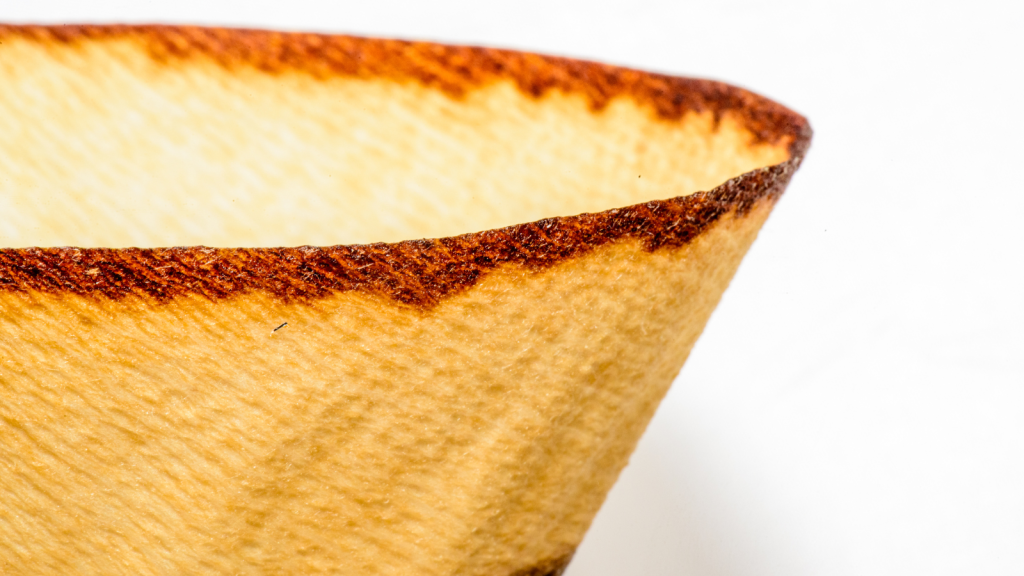
Used Coffee Filter | iPandastudio – Getty Images Signature
In addition to coffee filter shapes and sizes, they also come in different materials. Many of us think about filters and go right to disposable coffee filters, but there are plenty of reusable coffee filters out there. You can often find the same type of coffee filter in various materials that will fit your brewing device, so the best coffee filter material is simply up to personal preference.
Paper Coffee Filter
Paper coffee filters are the most common type of coffee filter material due to ease of use, affordability, and resulting cup quality. They come in two types: bleached vs. unbleached coffee filters.
Fun fact: Melitta Bentz invented and patented paper coffee filters in Germany after searching for a solution to the coffee grounds that kept ending up in her cup. She went on to create the Melitta Bentz Company in 1908.
Bleached paper coffee filters are treated with chlorine or oxygen to whiten the paper. While the bleaching process doesn’t add other flavors to your coffee, there is an environmental concern that comes with pollution from the paper-bleaching industry. Most coffee filters are oxygen-bleached now, which requires less manufacturing.
Unbleached paper coffee filters require less processing than bleached filters and retain most of the natural tan color of wood pulp. While some argue that unbleached filters leave more of a papery taste in brewed coffee, bleached filters are just as likely to contribute a papery taste.
That’s why regardless of using bleached vs. unbleached coffee filters, you should always rinse the filters with water to wash off some of that papery taste before adding your coffee grounds.
Paper coffee filters are generally biodegradable and compostable in the right environment, so you can reduce waste if you have access to compost facilities.
Metal Coffee Filter
Metal coffee filters are made from stainless steel or mesh. These reusable coffee filters are workhorses, lending to more environmental sustainability and waste reduction. Due to the larger pores in metal coffee filters, more coffee oils and sediment can pass through while brewing, resulting in a fuller-bodied and visually darker, and cloudier coffee.
It’s relevant to note that coffee brewed with metal filters is generally considered unfiltered coffee since the mesh is only really capable of keeping coffee grounds out of the cup and does little to filter out any other compounds. The importance of filtered vs. unfiltered coffee will be covered later in this article when we talk about the health effects of drinking coffee.
Metal filters are usually a one-time purchase, provided you maintain them carefully with a thorough cleaning. Otherwise, micro-fines, oils, and other grime can accumulate on the filter and dramatically affect the flavors of your next brew.
Cloth Coffee Filter
Similarly, cloth coffee filters can be reused, again and again with a thorough cleaning. Some cloth coffee filters are made from cotton, hemp, linen, or nylon and come in all the shapes above. Many cultures traditionally used nylon socks to brew coffee throughout history. The woven fibers of cloth filters catch more fines and oils than metal filters but still allow some oils to pass through, resulting in a balanced, heavy-bodied cup of coffee.
You can reuse a cloth coffee filter over one hundred times before accumulated compounds interfere with your brew. However, cloth filters must be washed and carefully stored between uses. Some recommend keeping cloth filters submerged in a refrigerated container of water or even freezing the filter in a container or ziplock bag to maintain food safety and avoid absorbing unwanted smells.
What type of coffee filter do I need for…
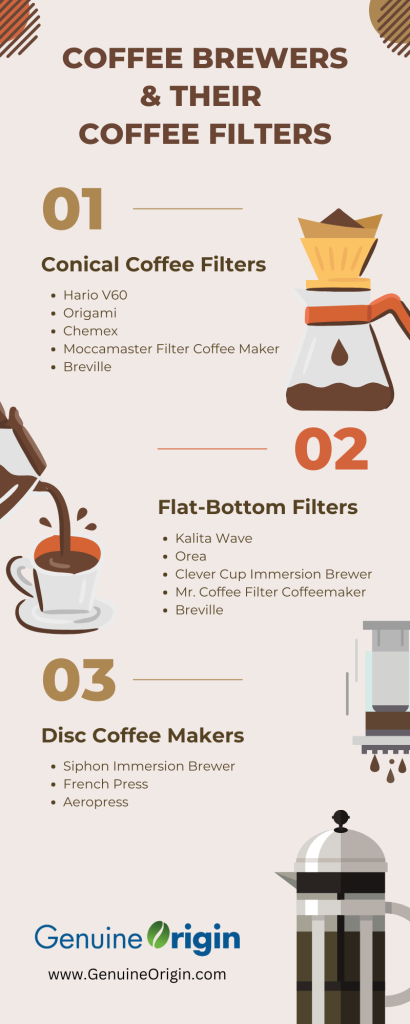
Coffee brewers and their coffee filters infographic
Hario V60 pour over coffee dripper
- Conical filters, with the most common being Hario V60 paper coffee filters or conical metal or cloth filter alternatives.
Kalita Wave pour over coffee dripper
- Flat-bottom filters, with the most common being Kalita Wave paper coffee filters or flat-bottomed metal or cloth filter alternatives.
Origami pour over coffee dripper
- Conical filters, with the most common being Origami paper coffee filters. If Origami filters are unavailable, you can substitute them with a Hario V60 conical filter or Kalita Wave flat-bottom filter.
Orea pour over coffee dripper
- Flat-bottom filters. Orea recommends using the flat disc Negotiator paper filter fitted with the flat-bottom Negotiator tool or the Orea version of the Sibarist flat-bottom paper filter. You can also substitute with a Kalita Wave flat-bottom filter.
Chemex pour over carafe
- Conical filters, with the most common being trademarked Chemex paper filters that are folded into a conical shape and are thicker than most paper filters available. The extra thickness filters out most of the oils and fines for a very clean cup.
Clever Cup immersion brewer
- Flat-bottom filters, with the most common being Clever Cup paper coffee filters or flat-bottomed metal or cloth filter alternatives. You can also substitute with Kalita Wave or Melitta paper coffee filters.
Aeropress manual coffeemaker
- Disc filters, the most common being Aeropress paper coffee filters or disc-shaped cloth or metal filters.
French Press immersion brewer
- Disc filters. French Press coffee brewers come with a fitted metal mesh filter attached to the plunger.
Siphon immersion brewer
- Disc filters, with the most common being cloth or metal filters, or paper disc alternatives.
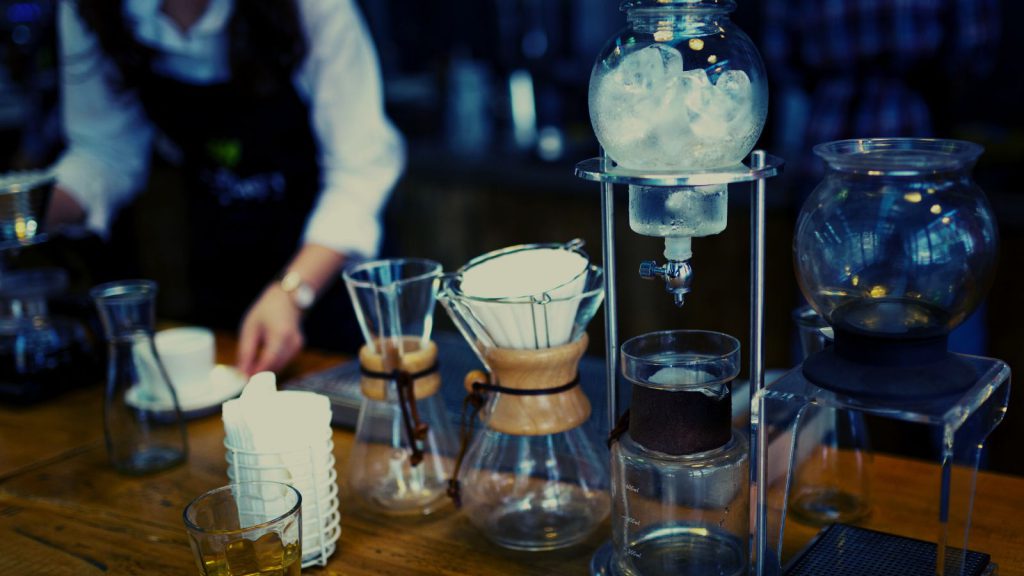
Assorted Brewing Devices at coffee bar – Image by Quang Nguyen Vinh from Pexels
Mr. Coffee filter coffeemaker
- Flat-bottom filters. Most Mr. Coffee filter coffee machines come fitted with a permanent flat-bottomed reusable basket filter made with a nylon mesh and do not require an additional paper filter.
Moccamaster filter coffeemaker
- Conical filters with a flat bottom instead of a tapered edge, the most common being Moccamaster paper coffee filters. You can also substitute with a Melitta conical paper filter.
Breville / Sage filter coffeemaker
- Breville (also known as Sage if you’re in Europe) drip coffee machines like the Precision Brewer come with two interchangeable types of baskets, a conical one and a flat-bottomed one, to suit your brewing preference. Depending on how you like your coffee, you can use either one with the corresponding shape of paper filter in size #4.
Do you need a coffee filter for a pod, capsule, or espresso machine?
Keurig K-Cups
- Most K-Cup pods come pre-packaged with filters inside the pod, so you don’t need an additional filter to brew a K-Cup. However, you can opt for a reusable K-Cup filter that acts as a refillable pod you can use again and again with your favorite ground coffee.
Nespresso capsules
- Similarly, Nespresso capsules also come pre-packaged with a lid that acts as a coffee filter when punctured by the Nespresso machine. Reusable Nespresso pods are also available in plastic or metal that you fill with ground coffee yourself.
Espresso machine
- Espresso machines come with an attachment called a portafilter, which is basically a metal basket attached to a handle. The basket holds the coffee grounds and is locked into the espresso machine’s group head, where hot water is forced through the basket under high pressure to extract a concentrated shot of espresso coffee. Depending on how much ground coffee you want to brew, you can use different basket sizes for the portafilter.
Filtered vs. Unfiltered Coffee
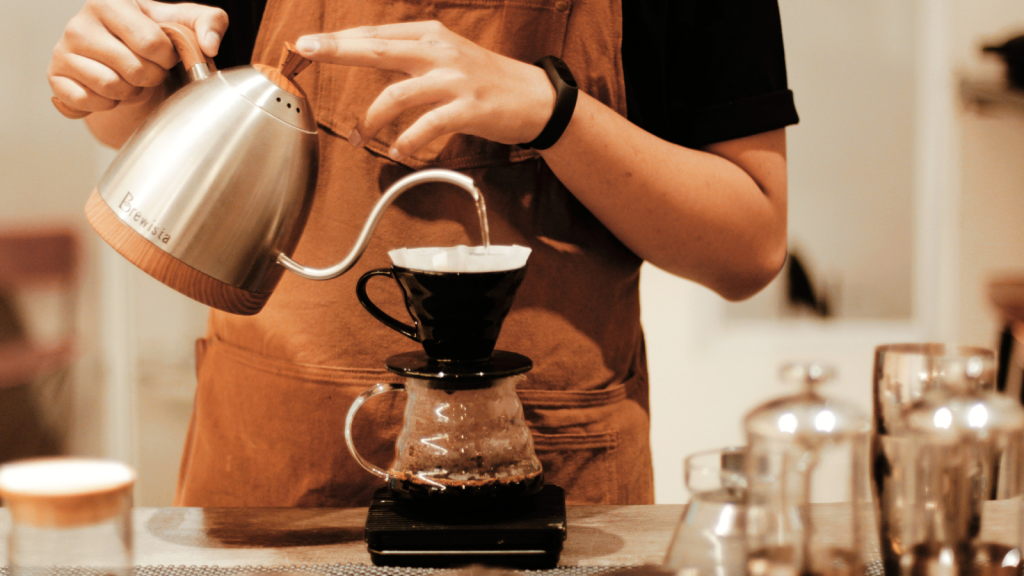
Barista brewing pour over coffee | Img Andreantian
The main difference between filtered vs. unfiltered coffee is in the flavor profile. By filtering coffee through a paper, cloth, or metal filter, you trap oils and fine particles from going into your cup. As a result, filtered coffee is often described as “clean” and “bright,” with more nuanced flavor notes and a less heavy mouthfeel.
Unfiltered coffee, on the other hand, contains more oils and fine particles that add to a heavier mouthfeel and stronger flavor in the cup. French Press, Turkish, Moka Pot, and espresso coffee fall in the unfiltered category because the mesh filters they come with are generally not fine enough to catch anything smaller than the actual coffee grinds and thus do little to filter out any oils or impurities.
Is it healthy to drink unfiltered coffee?
There are many health benefits to drinking coffee every day. However, experts recommend drinking filtered coffee over unfiltered coffee to maximize these health benefits. The latter contains chemical compounds that may contribute to raising LDL or “bad” cholesterol and triglyceride levels, which can cause cardiovascular problems like heart attacks. These compounds are usually filtered out with a paper or cloth coffee filter, making filtered coffee a better choice for people at risk for cholesterol or cardiovascular health issues.
The choice between filtered vs. unfiltered coffee ultimately comes down to personal preference for taste and individual health factors. That’s something to remember when choosing the best coffee filter for your daily routine.
Disclaimer: The links provided in this blog are not sponsored and are intended solely for informational purposes. We do not receive any compensation or benefit from the products or services linked to in this blog. Any purchase or use of these products or services is at your own discretion and risk. We do not assume any responsibility for the quality, safety, or effectiveness of any products or services linked to in this blog.

